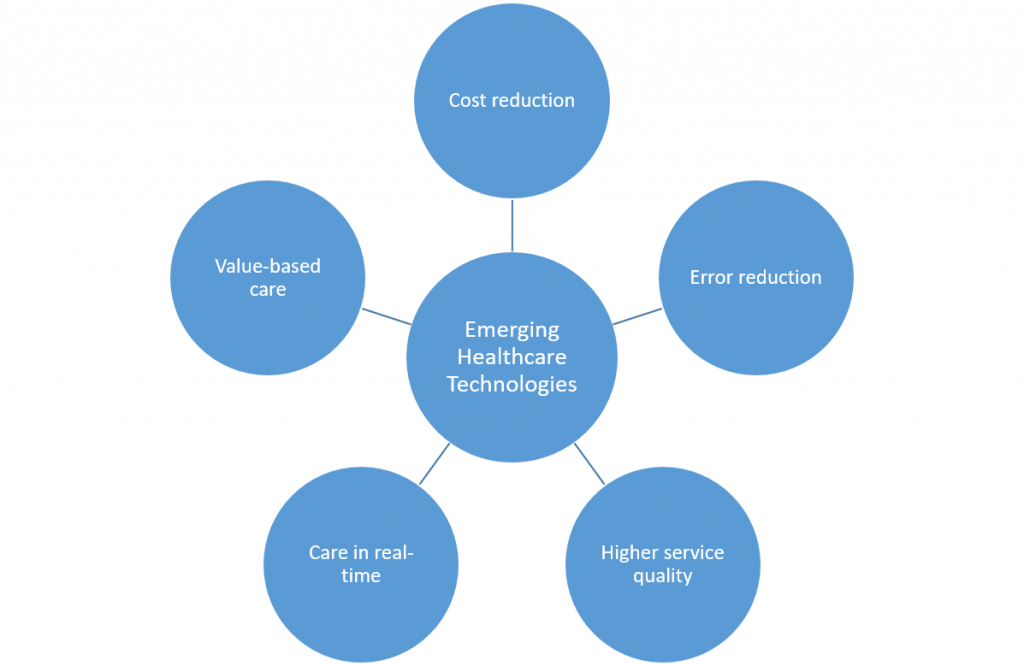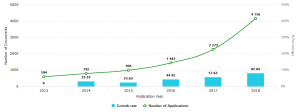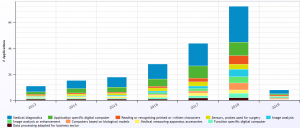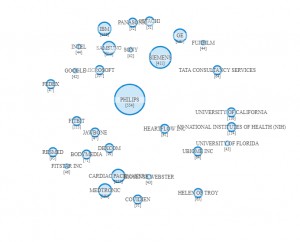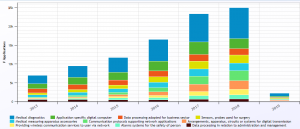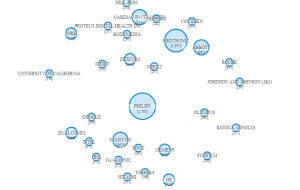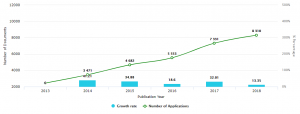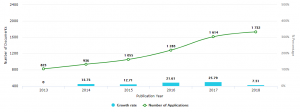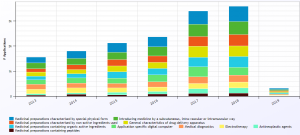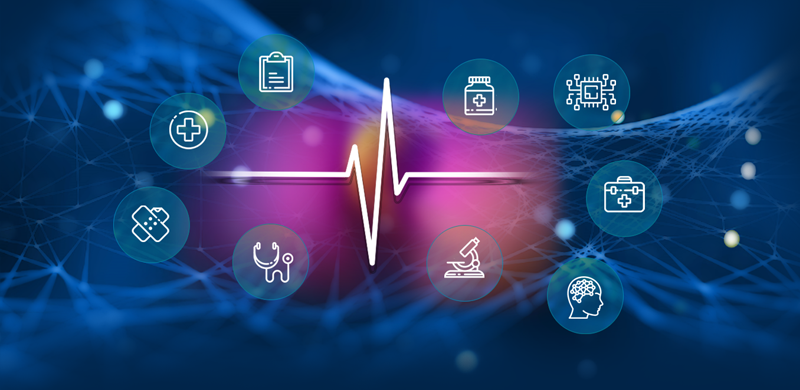
The healthcare industry is moving towards a new frontier of human well-being with the advances in technology. Healthcare-related data amassed from numerous sources including electronic health records, medical imaging and diagnostics, pharmaceutical research, wearables and medical devices, is being used to propel these changes.
The challenge that the healthcare sector faces today is how to make use of these advances in technology while maintaining the high quality of patient care, and without compromising on the privacy of patient data. We take a closer look at the emerging trends in healthcare technologies by analyzing patents in these areas in the last five years. In the rapid change that is taking place, we notice a few recurring themes in the directions that the healthcare providers are adopting.
In this article, we look at some of the emerging technologies that are being applied in healthcare. These include Artificial Intelligence (AI), the Internet of Things (IoT), various Digital Health initiatives and Smart Drug Delivery systems. We have covered these technologies in detail in our earlier patent landscape reports. In this article, we have studied the trends in the last five years and have included charts and tables with updated numbers for the same.
Artificial Intelligence in Healthcare
The adoption of AI technologies by healthcare providers is gaining momentum and resolving many issues facing the healthcare sector. AI in healthcare is in its nascent stages and is rapidly growing. It is expected to grow from $663.8 million (2014) to reach $6.6 billion by 2021, at a CAGR of 40-50%.
Along with powering predictive analysis, AI in healthcare is being applied in areas such as using data for personalized medications, automated treatment plans, wellness management and patient monitoring, among others.
Figure 1.1 shows the growth of patent publications related to AI technologies in healthcare – specific to Healthcare Informatics and Medical Diagnostics – in the last five years. The patent publications have grown steadily with sharper growth from 2017 to 2018.
Some of the ways in which AI technologies are changing the healthcare sector are given below.
- Information gathering and analysis (medical records and patient information) using AI and digital automation.
- Medical diagnostics – tests, X-Rays, CT scans, data entry, and other related tasks.
- Predictive analytics – early detection of diseases and better treatment plans using patient historical data.
- Monitoring the patient’s fitness level and delivering optimal patient care.
Figure 1.2 shows the evolution of AI technologies in healthcare related to healthcare informatics and medical diagnostics. Sub-technologies related to Patient Data Processing, Remote Monitoring, Health Risk Assessment and Medical Imaging exhibit high patenting activity. To view the complete report on emerging trends in AI technologies, click here.
With advancements in fuzzy logic and deep neural networks, AI in medical devices and imaging techniques is also witnessing fast adoption by the healthcare providers.
Figure 1.3 shows an Assignee Topic Map for the key players in the AI technologies related to healthcare informatics and medical diagnostics. The size of each bubble in an Assignee Topic Map represents the total number of patent assets held by each company in these areas, and the bubble proximity represents the similarity of their overall portfolios.
It is observed that the larger players such as Philips, Samsung and IBM hold a large number of patents related to Bio-sensors, which is an emerging technology in the healthcare sector.
Internet of Things (IoT) in Healthcare
Various devices and mobile applications are being used now by health practitioners to track and prevent chronic illnesses. This has led to the emergence of the Internet of Medical Things (IoMT). A variety of wearables are in use for gathering and tracking the data, including ECG/EKG monitors. The use of these devices mainly involves the following:
- Collection of data using sensors,
- Gathering data over the network, and
- Analyzing data for decision making.
This enhances the efficiency of the current processes and provides an impetus for the development of new products and services in multiple application areas.
According to Frost & Sullivan, the adoption of IoMT systems in healthcare stood at around 60% in 2017. Allied Market Research forecasts that the global IoMT market is expected to garner $136.8 billion by 2021, registering a CAGR of 12.5% during the forecast period of 2015-2021.
Figure 2.1 shows the growth of published patent applications for IoT related to healthcare. A sharp growth is seen from 2016 to 2017, which most likely is due to the increasing adoption of smart wearables and IoMT in the healthcare sector.
Figure 2.2 shows the evolution of technologies related to IoT in healthcare. Typically, data is monitored and collected using smart devices and sensors. At present, devices such as smart inhalers for treating bronchial asthma, syringe pens for the treatment of diabetes mellitus, and smart medicines are being widely developed and finding their place in the market. These technology-aided solutions facilitate diagnosis and provide improved treatment and patient care.
Figure 2.3 shows the Assignee Topic Map for the key players in the IoT related to healthcare space.
The main challenge facing the industry is providing consistent and effective communication between the numerous medical IoT devices. Connectivity issues and potential security concerns are other impediments for the growth of IoMT systems. Read our report containing business case studies related to IoT in healthcare.
Digital Health
Innovations directed to digital health are on a rise. Novel devices and applications have entered the healthcare sector, from wearables to genomics to personalized medicine, that aid in disease diagnosis, and their prediction, management and treatment. In this increasingly connected world and with the ubiquitousness of data collection, the healthcare sector is employing advanced analytical techniques to optimize patient care and doing so in a cost-effective manner.
Figure 3.1 shows the growth of patent publications related to digital health applications. These technologies exhibit a continuous upward trend over the last five years.
Digital technologies in the healthcare sector are constantly evolving and while new applications are emerging, the technologies driving these remain almost constant.
As seen in Figure 3.2, application specific devices and medical diagnostics are the fast-growing technology segments in digital health.
Some of the common underlying technologies for these areas include big data applications, augmented reality systems and machine learning algorithms.
Figure 3.3 displays the Assignee Top Map for the key players in the digital health sector.
Philips, Samsung and GE are the top companies in digital health-related applications. To read our complete report on digital health, click here.
Mobile and digital health applications provide flexibility to both practitioners and patients as well as improve healthcare outcomes. According to a research study by Transparency Market Research (TMR), the global digital health market was worth US$179.6 billion in 2016. Expanding at a CAGR of 13.40% during the period from 2017 to 2025, the market is projected to reach US$536.6 billion by the end of the forecast period.
Smart Drug Delivery Systems
Smart drug delivery systems (SDDS) cover intelligent approaches in formulation technologies that transport a drug dosage to its target site in the body. These systems use sensors and monitoring devices to track and analyze patient information. There are various innovative drug delivery approaches such as liposomes, polymeric micelles, nano-based carriers and dendrimers.
Figure 4.1 shows the growth of patent publications related to smart drug delivery systems. The progress in these technologies has overcome the challenges associated with traditional methods of drug delivery, such as reduced drug solubility, systemic toxicity and poor oral bioavailability.
Figure 4.2 illustrates the evolution of technologies related to SDDS in the last five years. These show steady growth over the years. The technologies related to medicinal preparations characterized by special physical form such as smart pills and the introduction of medicine by subcutaneous or intravascular way, form the largest share of the segment.
The incorporation of telehealth solutions into these new age smart drug delivery systems provides health practitioners with real-time patient data and equips them to deal better with chronic diseases.
Advanced SDDS such as nanomedicines are being used to provide better treatment for terminal pathologies and helps the practitioners to access patient data easily.
Figure 4.3 shows the Assignee Top Map for the key players in SDDS. Read our complete report on smart drug delivery systems here.
Quick Takeaways
- Artificial Intelligence technologies in healthcare are significantly impacting the healthcare ecosystem, especially in the areas of diagnostics and pathology.
- IoMT is emerging as a critical component of healthcare systems and is being increasingly adopted by the providers for leveraging patient data and care management.
- Digital health is transforming the healthcare industry with precise treatment, monitoring and diagnostics.
- Smart drug delivery systems are delivering improved safety and therapeutic benefits to patients. They are also enabling real-time analysis of the patient’s health data.
